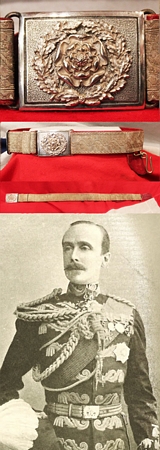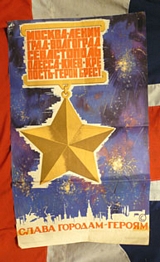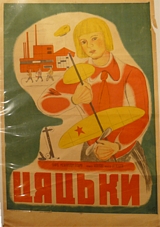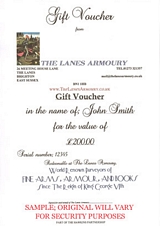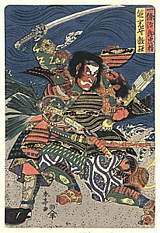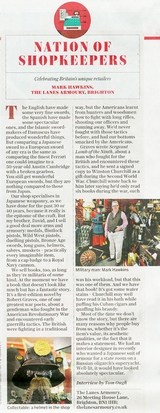A Fabulous Imperial German Air Service Flask & Cigarette Case
This is just the epitome of all things Imperial German from the time of Kaiser Willhelm and Baron von Richthofen. The reservists flask was a peculiarly German artifact, and alongside the bier stein absolutely typical of the Germanic age of the early 20th century. The flask is an alloy depicting an embossed Zeppelin, an embossed plane and another, an anchor and a panel for luftschiff reserve service, and a similar for the flieger reserve service. It has a mono plane cup holder with a young pilot and his fraulein drinking and reveling. The front panel opens on a hinge revealing a picture behind the flask and a holder for cigarettes. It has wear and aging, but for the Imperial German WW1 reservist flask and stein collector you could probably not find a better or more desirable example. Overall 9 inches tall by 5 inches wide by 2 inches deep read more
395.00 GBP
Every Customer Should Expect & Will Receive Our World Renown 5* Star Service, Day In, Day Out, 365 Days of the Year
We have received the greatest honour of being described by almost every visitor to our store in Brighton, as possibly, the very best and most remarkable specialist shop in the country, if not the world. Our standards of personal service, honed through the generations for over 100 years, we hope, are second to none, and every possible effort is made to create the best possible atmosphere and assistance, for every single customer, be it for a single item, or hundreds, in person, or via our website.
No stone is left unturned in order to ensure every single customer’s buying or selling experience is a pleasure and a joy. Thankfully, dozens of you confirm this to us every single day, these days electronically, and for that we cannot thank you enough. Stay Healthy, Stay Safe. read more
Price
on
Request
Original Lewis & Vickers Machine Gun Crates
Just uncovered from long-term storage in our gun room, acquired over the past 50 to 60 years.
Original Lewis and Vickers machine-gun transit cases. Designed and constructed by the British ordnance and made to exacting standards, to suffer the vagaries and exertions of wartime combat on the front line, and storage of machine guns for up to, and over, 100 years. Solid wood with all metal edge strengthening supports. They were designed to be thrown around and heavily manhandled on the backs of army trucks, tanks, and armoured vehicles in combat war situations, even to be dropped out of planes for arms supply drops behind enemy lines, they are incredibly strong.
Beautifully designed constructed and perfect for storage, and historical collectors. Also absolutely ideal for a deactivated Lewis or Vickers machine gun collectors to complete historical display.
***Available for UK collection only***. They are available for collection from our Brighton gun shop on a click and collect basis by appointment. Please telephone or email for details. They are simply incredible value probably couldn’t be made for 10 times the price. Call 07721 010085. We have seen these sell for over £200 each in the past, when they have been rarely available
We also have some Bren gun cases And Russian USSR maxim machine-gun transit cases. Some are stencilled others are plain. We do not have any of the actual guns available for sale at present. read more
90.00 GBP
A Superb English Lord-Lieutenant's Silver Belt and Silver Lace Bullion Belt
Victorian. The silver buckle bears a centrally mounted English rose motif with an oakleaf and acorn wreath surrounding. A red Morocco leather lined belt which is covered in pure silver silver lace brocade bullion, in the continued design of the highest rank oak leaf and acorn scrolling vine, representing the monarch's personal representative, the Lord Lieutenant.
The Lord-Lieutenant is the British monarch's personal representative in each county of the United Kingdom. Historically, the Lord-Lieutenant was responsible for organising the county's militia. Lieutenants were first appointed to a number of English counties by King Henry VIII in the 1540s, when the military functions of the sheriff were handed over to him. He raised and was responsible for the efficiency of the local militia units of the county, and afterwards of the yeomanry, and volunteers. He was commander of these forces, whose officers he appointed. These commissions were originally of temporary duration, and only when the situation required the local militia to be specially supervised and well prepared; often where invasion by Scotland or France might be expected.
Lieutenancies soon became more organised, probably in the reign of his successor King Edward VI, their establishment being approved by the English parliament in 1550. However, it was not until the threat of invasion by the forces of Spain in 1585 that lieutenants were appointed to all counties and counties corporate and became in effect permanent. Although some counties were left without lieutenants during the 1590s, following the defeat of the Spanish Armada, the office continued to exist, and was retained by King James I even after the end of the Anglo-Spanish War.
The office was abolished under the Commonwealth, but was re-established following the Restoration under the City of London Militia Act 1662, which declared that:
The King's most Excellent Majesty, his Heirs and Successors, shall and may from Time to Time, as Occasion shall require, issue forth several Commissions of Lieutenancy to such Persons as his Majesty, his Heirs and Successors, shall think fit to be his Majesty's Lieutenants for the several and respective Counties, Cities and Places of England and Dominion of Wales, and Town of Berwick upon Tweed.
Although not explicitly stated, from that date lieutenants were appointed to "counties at large", with their jurisdiction including the counties corporate within the parent county. For example, lieutenants of Devon in the seventeenth and eighteenth centuries appointed deputy lieutenants to the City of Exeter, and were sometimes described as the "Lieutenant of Devon and Exeter" The origin of this anomaly may have lain in the former palatine status of Pembrokeshire.
The City of London was uniquely given a commission of lieutenancy, and was exempt from the authority of the lieutenant of Middlesex. The Constable of the Tower of London and the Warden of the Cinque Ports were ex-officio lieutenants for the Tower Hamlets and Cinque Ports respectively, which were treated as counties in legislation regarding lieutenancy and militia affairs.
The official title of the office at this time was His or Her Majesty's "Lieutenant for the county of ..", but as almost all office-holders were Peers of the realm, they were referred to as "Lord-Lieutenant". read more
385.00 GBP
A Stunning Russian Cold War Era Poster
Original poster with interesting subject matter of medal of a Hero of the Soviet Union. This is one of a collection of Russian USSR posters we have acquired from the estate of an ex British Glider Pilot of WW2. This poster is folded and in condition as seen in the photos. Dated 1968 38 inches x 22 inches. This poster would look super nicely framed read more
275.00 GBP
Original Russian Soviet, USSR 1930's Propaganda Poster
Unusual poster with munitions factory, airship and young woman with plane. Early Russian posters of the Lenin and Stalin period before the war are now becoming extraordinarily collectable. Another poster for the Battleship Potemkin [a Russian historical silent film that is shown in our gallery for illustration purposes] designed by the Stenberg brothers in 1925, sold in November 2012 for 103,250 Pounds Sterling at Christies Auction in London. It arranged class elements into a powerful design of revolutionary upheaval. The poster comprises three pictorial elements: the battleship, the officer and the able seaman. Each of these signs is placed in relation to the others. The fragile balance of bourgeois society is revealed at its very tipping-point.
We never normally comment on the investment potential of any collectable, but the potential for all underpriced WW1 and WW2 posters must be incredible, for example the more famed poster, 'Keep Calm and Carry On' can now sell for over £20,000.
Photographed in plastic protector frame case. Sent unframed when purchased 24.5 inches x 37 inches read more
825.00 GBP
A Super Collection of 300 20th Century Books of Military Interest Arrived This Week!!
Acquired from a former military officer and collector of historical reading matter. Please email us details of any out of print military based book, historical, reference et cetera et cetera, printed in the last century, that you have been looking for, and we may have it within the collection. We have been promised another 500 volumes, including over 30 various books signed personally by Winston Churchill, that he still retains, hopefully they should arrive with us after lockdown sometime in the New Year.
Every Customer Should Expect & Will Receive Our World Renown 5* Star Service, Day In, Day Out, 365 Days of the Year
We have received the greatest honour of being described by almost every visitor to our store in Brighton, as possibly, the very best and most remarkable specialist shop in the country, if not the world. Our standards of personal service, honed through the generations for over 100 years, we hope, are second to none, and every possible effort is made to create the best possible atmosphere and assistance, for every single customer, be it for a single item, or hundreds, in person, or via our website.
No stone is left unturned in order to ensure every single customer’s buying or selling experience is a pleasure and a joy. Thankfully, dozens of you confirm this to us every single day, these days electronically, and for that we cannot thank you enough. Stay Healthy, Stay Safe. read more
Price
on
Request
A GIFT VOUCHER FOR ANY AMOUNT CAN BE WITH YOU WITHIN THE HOUR !
A Gift Voucher is often the ideal solution to leave the decision of the item to choose to the person you wish to gift. They can choose any form of militaryantiques and militaria or books they wish. They can be with you via email within the hour, if you call us direct during opening hours, or by the next day if you contact us out of hours. They are simple to print off at home, and sometimes it can be the perfect solution to that last minute need during these difficult times. They are available from us for all values, and as required, and are entirely bespoke to the recipient. All are unique and customised for each and every occasion. We have priced this sample example as our £200.00 voucher, but you can specify any alternative amount at all in the 'comment' section in the Webstore Order page, or call us direct. Our unique bespoke Gift Vouchers are valid without time limit for use at the recipients convenience at any time in the future. Just call 01273 321357 or 07721 010085 read more
Price
on
Request
Please View Probably The Best Selection Of Original & Varied Samurai Arms in Europe & Possibly the World
Please View One of The Best Selections Of Original Samurai Arms to be Seen. Over the past 49 years I have personally supervised our company's determination to provide the most interesting, educational, yet not too intimidating, gallery of original Japanese Samurai weapons, helmets, sword fittings, polearms, muskets and armour. Principally concentrating on swords and daggers, with a combination of age, beauty, quality and history. Thanks to an extensive contact base [built up over the past 100 years or more] that stretches across the whole world, including collectors [both large and small], curators, academics and consultants, we have been very fortunate, that this effort has rewarded us with the ability to offer, what we believe to be, the most comprehensive selection available in Europe, if not the world, and during that time we have handled likely tens of thousands of original samurai artefacts and swords. In one week I sent over 300 samurai swords and daggers to be sold at our business in Georgia, USA [in the 1970’s we found the best market for Japanese swords was America]. Some of the most learned scholars studying this art all their lives often only scratch the surface of the knowledge to be learnt in this field, and like them, we have always loved the incredible history of the Samurai, and admired, respected and envied the unparalleled quality and beauty of their swords. Our Japanese weapons vary in age up to 800 years old, and are frequently some of the finest examples of specialist workmanship ever achieved by mankind. We have tried to include, within the description of some items, a brief history lesson, for those that are interested, and may not know, that will describe the eras, areas and circumstances in which these items were used. We have tried our utmost to be informative and interesting without being too academic in order to keep the details vibrant, fascinating yet not too complex. Please enjoy, with our compliments, our Japanese Gallery. It has been decades in the creation, and we intend it to remain interesting and informative, hopefully, for decades to come. Although they appear to be likely a relative expensive luxury compared to other antique swords from other nations, they are in fact incredible value for money, for example a newly made bespoke samurai style sword blade from Japan will cost, today, in excess of £11,000, take up to two years to complete, will come with no fittings at all, and will be modern [naturally] with no historical context or connection to the ancient samurai past in any way at all. Our fabulous original swords can be many, many, hundreds of years old, stunningly mounted as fabulous quality works of art, and may have been owned and used by up to 30 samurai in their working lifetime. Plus, due to their status in Japanese society, look almost as good today as the did possibly up to 500 years ago, or even more. Mark Hawkins [Partner]. read more
Price
on
Request
A Feature on The Lanes Armoury in the London Daily Telegraph
Celebrating Britain's Unique Retailers; A most kind review of Mark Hawkins and The Lanes Armoury by Tom Ough of the Daily Telegraph. See a scan of the article, as it appeared in the Daily Telegraph, in the gallery. This other review was completed earlier this year; Mark Hawkins celebrates 50 th year at The Lanes Armoury this year [2021].The story so far of the Hawkins Brothers and "The Lanes Armoury" written and updated by Frank Taylor; Sadly it is likely the last, true, original 'armoury' shop left in the whole of Britain. They were described as one of the most highly recommended visitors attractions in the whole of the UK by the New York Times. It is also regularly featured by many other world wide publications, appearing in too many television programmes to list, including Italian and Japanese documentaries, plus the Discovery Channels "Mud Men", and Ian McShane's world famous tv series, "Lovejoy". Several film locations have been filmed in their shops, including Graham Greene's " Brighton Rock", and Roger Moore's film series "The Persuaders", way back in 1971. Hundreds of thousands of tourists [and regular visitors] come to see them every single year, including in the 1970's President Ronald Reagan, and in October 1970 Elizabeth Taylor with Richard Burton also visited [and it was during that extraodinary visit Elizabeth Taylor sold to Camilla, {Mark and David's mother}, her bespoke diamond and ruby encrusted Rolex watch]. Also in the 1960's Edward G. Robinson visited, and H.M. Queen Elizabeth and HRH Prince Philip came through the Lanes, and their store in the 1980's, as did the HRH the Aga Khan. The 'Hawkins brothers' evolved their company from one of the oldest established family businesses in Sussex, with a client base that includes museums, heads of state, presidents, princes and kings. But whether you are a movie star, a head of state or a student, all will be treated with the same courtesy and respect. Every sale is important to them, albeit a £5 badge, a £500 sword, a £50,000 medieval book, or maybe a Gothic suit of armour for £40,000. Every day they are told that to some, this is their favourite shop in the world, with some foreign visitors returning year in year out for 40 years or even more, so they truly believe they have a great responsibility to their customers, their reputation, and to the amazing city of Brighton. Their oldest customer has incredibly been a regular buyer, for an amazing, over 75 years. The partners, Mark and David regularly appear on the BBC and numerous UK TV channels on various antique 'discovery' programs, and act as consultant appraisers. During Mark's 48 years, and David's 36 years [that's over 80 years combined] with the family business, it is estimated they have had pass through their hands, and appraised, possibly more items than any other living dealers in the country, and their breadth of knowledge and experience is simply astonishing. While in his capacity as export director of the old family company Mark was personally responsible for the sale and export of over 2,000 individual antiques, armouryantiques and militaria items every single week for nearly ten years. Shipping their treasures to the four corners of globe. Of course, these days [and for the past 30 years] the brothers are concentrating their attention to being England's leading specialist arms and militaria dealers, limiting their business to fine, ancient, antique or vintage samurai weaponry, armour, militaria and historical books, covering the past three millennia. It is now said they are the largest samurai weapon dealers in the western world, and this website is the largest of it's type in the world including over 17,0000 full colour photographs of some of their items for sale.
With so many different histories to offer, you can feel freer in Brighton than in most British cities to select trips which coincide with your interests and of course, you're much more likely to find in Brighton things to do which bring the history you love to life. For the lover of militaria, a visit to The Lanes Armoury is a must with a difference. The Armoury's housed in a three-storey 16th century building and is a real treasure trove, it's a museum which is not a museum as everything is for sale. It has been nominated and then short-listed for the British Antique & Collectors Awards as the best Antique Shop in Great Britain and is the latest incarnation of a much older business David Hawkins [Brighton] Ltd which was one of the earliest and largest dealers in Antiques and Collectibles within the whole of Europe in the last century. It's their current specialisation in Arms, Armour, Militaria, and Books which really marks them out and creates such a fascinating and fantastic place to visit. From bronze-age swords, axes and daggers, suits of samurai and European armour, muskets, revolvers, duelling pistols, American civil war swords, right through to medals and World War II militaria, it's all there to be viewed and drooled over. For example, they have in stock at present a 19th century 'Vampyre Killing Kit', [near identical to one in the Tower Collection] essential for those Victorian trips to the Carpathian mountains and Transylvania, and last year had a signed 1st Edition book that once personally belonged to Winston Churchill detailing a story of combat in the American Revolutionary War. It was presented to him during WW2 and signed by it's author, Robert Graves, one of England's greatest WW1 poets and novelists. It was declared by Churchill, in a personal letter to Robert Graves thanking him for the gift, that it was one of only 6 or 7 novels that he had read during his premiership in the war, and subsequently this very book was used by him to advise the creation and modus operandi of the new British Commandos. They have two pages in a folio from one of the earliest printed books, and a Ist Ed, book of 1479 By Bartolomaeus Platina, and just recently in, an Autographed copy of Christmas Carol by Charles Dickens at just under £25,000 [now sold]. It's not a museum, although often believed to be, and when you leave, you've really have had the same experience! I can honestly say the experience of a visit to the armoury, although not a vast premises by any means, in fact probably the smallest recommended by the New York Times, but is utterly memorable, and every single person that passed through their doors while I was there was either astonished, amazed, or both! But remember, although it looks and feels like a museum, as the brothers reminded me, everything is for sale!.... read more
Price
on
Request





